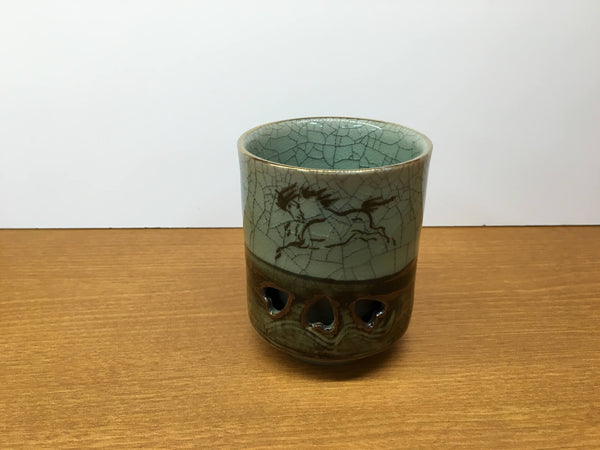
Soma ware (Soma yaki):Unveiling the Charm of Fortunate Horse Pottery
Soma ware is treated as a lucky charm. It is also used as daily necessities such as teacups, teapots, and plates. In this article, we will introduce Soma ware, which has unique characteristics.
What is Soma ware?
Soma ware is pottery produced in Fukushima Prefecture, located in the Tohoku region of Japan. It is also called "Obori Soma ware" because it is produced in the Obori area. Soma ware is made in such a way that it does not easily cool down even when filled with hot water and that your hands do not get hot when you hold the cup, which is related to the unique way of making Soma ware. This may be because the Tohoku region is one of the coldest regions in Japan.
In fact, Soma ware can be divided into two major types: "Obori Soma ware" and "Soma Koma-yaki. The main differences are "purpose" and "maker”. “Obori Soma ware" was mainly produced as daily utensils for the common people to use in their daily lives, and its makers were farmers who worked as a side job for a half-farmer, half-turner craft. On the other hand, "Soma Koma-yaki" was produced as an offering to the feudal lord Soma, and was heavily protected as an official kiln. Although Soma Koma-yaki is no longer produced, the kiln was designated as an Important Tangible Folk Cultural Property by Fukushima Prefecture and is open to the public.


The origin of such Soma ware pottery dates back to the Edo period and boasts a history of about 300 years. Let's take a look at how the history of Soma ware has led to the current Soma ware.
History of Soma ware
The history of Soma ware dates back to the Edo period in the 17th century, about 300 years ago. It is said that it started when Hangai Kyukan, a potter in Obori village under the Soma clan, made tea bowls using pottery techniques and sold them by painting pictures of pieces on them. With the support of the Soma clan, the pottery industry grew, and kilns spread to eight neighboring villages. By the end of the Edo period, the number of kilns had increased to 100, and the birth of celadon glaze, which is a characteristic of current Soma ware, was born.
During the Meiji period (1868-1912), due to a change in the administrative system (abolition of feudal domains), support from the clan was cut off and the number of kilns temporarily plummeted. Gradually, the number of potteries revived, and new techniques and unique styles were created. The techniques developed at that time gave rise to "double-layered" and "horse picture," which are still handed down today, and as demand changed, the production of kyusu (teapots) and tea bowls increased. During the Taisho period (1912-1926), the number of potters decreased due to the global recession caused by World War I and the draft caused by World War II. There was a crisis of closing the business for a while, but the kiln managed to overcome the crisis and has continued to keep the fire of the kiln alive until the present day.
In 2011, Fukushima Prefecture was hit by an unprecedented disaster, the Great East Japan Earthquake, which caused a nuclear power plant accident. The area including the Obori district became an evacuation zone, and at that time, Toyama Stone, the raw material of Soma ware, could not be used due to radioactive contamination. However, thanks to the determined efforts of the potters, they were able to use soil from the Seto area and continue production. Having overcome many difficulties, Obori Soma ware is still used by many people today.
Characteristics of Soma ware
Soma ware has many characteristics not found in other ceramics. Double-layered, Blue cracks, and Running pieces are all characteristics unique to Soma ware.
Double-layered

The double-layered structure is a technique unique to Obori Soma ware. The water does not get cold easily and is not hot to the touch. Fukushima Prefecture is in the northeastern part of Japan, and it is a very cold region, which may be the reason for this ingenious technique. The product of craftsmen's wisdom and ingenuity has evolved to be easy to use as daily necessities.
Blue crack
Cracks caused by the difference in shrinkage between the material and the glaze are called "kannyu" (penetration), and the characteristic ground pattern of these penetrations spreading throughout the celadon glazed ware is called "blue cracks". The "kannyu-no sound" produced when these cracks appear is a delicate and beautiful sound that has been selected as one of the "30 Sounds of Utsukushima". The sound is like a wind chime made of glass, and has a very beautiful tone.
Running pieces
Running pieces are used in the design of Soma ware. It is said to depict the "sacred horse" of the Soma clan that once ruled the area around present-day Namie-cho. The dynamic figure of the "running horse," painted with a skilled brush, has long been considered a good omen.
Left Horse
All horses depicted on Soma ware are painted facing left. This refers to the fact that "there is no one to the right," meaning that they are the most superior, and that there is no one superior to the others. They are popular as good luck charms and have been valued as gifts.
Nine horses
It depicts nine horses and is said to bring good luck. The nine horses are said to represent nine kinds of luck: luck in victory, luck in money, luck in success in business, luck in family, luck in love, luck in health, luck in business prosperity, good catches and harvests, and success in entrance examinations. Soma ware, with its good fortune, is sometimes given as a gift to celebrate the opening of a business, the opening of a store, or as a token of support for those who continue to take on new challenges.
